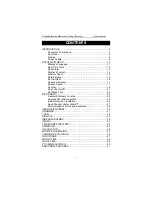
7-60
Setup Mode
Riffs
Stop
Use
the
Stop
parameter
to
specify
the
riff
stop
point.
Like
the
Start
parameter,
the
time
format
for
Stop
is
Bar
:
Beat
:
Tick
.
Bar
can
be
set
to
any
bar
in
the
sequence,
and
Beat
can
be
set
to
any
beat
in
that
bar
(beat
range
is
dependent
on
time
signature.)
Tick
can
be
set
from
0
to
959
.
Refer
to
Table 7
‐
6
for
Tick
values.
The
PC3K
restricts
the
selectable
values
for
the
Stop
parameter
such
that
the
current
riff
is
at
least
one
beat
long.
Transpose/Root Note
With
the
Transpose
parameter
set
to
On
,
the
riff
will
transpose
to
the
value
set
in
the
Root
Note
parameter.
So,
if
you
have
a
riff
whose
root
note
is
C4,
you
can
set
a
new
root
note
in
the
setup
so
that
the
riff
will
play
in
the
correct
range.
In
this
scenario,
if
you
want
to
trigger
your
riff
from
C1
but
it
was
recorded
at
C4,
you
would
set
Transpose
to
On
and
Root
Note
to
C1
.
Your
riff
will
now
play
in
the
desired
range
when
triggered
from
the
C1
key,
which
now
corresponds
to
the
note
C4.
SrcTrack (Source Track)
The
SrcTrack
parameter
determines
the
source
track
of
the
riff
(from
the
riff’s
original
sequence
in
Song
mode.)
Along
with
the
Start
and
Stop
parameters,
SrcTrack
allows
you
to
use
a
single
sequence
as
a
riff
for
many
zones,
and
to
select
a
different
source
track
and
Start/Stop
parameter
setting
for
each
zone
to
avoid
having
to
create
a
special
sequence
for
each
riff.
To
create
a
setup
with
multiple
riffs
each
playing
a
single
instrument
part,
set
a
single
track
for
the
SrcTrack
parameter,
and
that
track
of
the
sequence
will
play
with
the
program
on
the
current
zone.
Repeat
the
process
on
other
zones
using
the
same
song
for
the
riff,
but
using
a
different
SrcTrack
for
each
zone.
To
create
a
setup
with
a
single
riff
that
plays
multiple
instrument
parts,
set
SrcTrack
to
ALL.
Each
track
of
the
sequence
will
play
its
track
through
the
zones
which
have
corresponding
MIDI
channels
(MIDI
channels
are
set
for
each
zone
on
The
Channel/Program
(CH/PROG)
Page
of
the
Setup
Editor,
see
page 7
‐
6.)
Re Channel
Use
the
Re
Channel
parameter
when
the
current
zone’s
MIDI
channel
and
the
channel
that
the
riff
was
recorded
on
are
not
the
same.
When
Re
Channel
is
set
to
On,
the
track
selected
for
the
SrcTrack
parameter
will
play
through
the
MIDI
channel
of
the
current
zone.
For
example,
if
you
want
to
use
a
riff
on
zone
2/MIDI
channel
2
and
the
riff
was
recorded
on
track
4/MIDI
channel
4,
you
will
need
to
turn
Re
Channel
on.
If
you
were
to
do
this
and
keep
Re
Channel
set
to
Off,
the
riff
would
play
using
the
program
from
zone
4
instead
of
zone
2.
When
Re
Channel
is
set
to
On
and
ALL
is
selected
for
SrcTrack,
all
of
the
tracks
of
the
sequence
will
play
through
the
MIDI
channel
of
the
current
zone.
Note:
Track
numbers
don’t
have
to
match
MIDI
channel
numbers
in
Song
mode
(though
they
do
by
default.)
A
song
that
uses
non
default
MIDI
channels
for
its
tracks
can
cause
some
confusion
when
using
it
as
a
riff.
For
example,
using
a
riff
on
zone
1,
you
could
set
the
riff’s
SrcTrack
parameter
to
1,
and
expect
the
riff
to
play
on
zone
1
(if
it
is
set
to
MIDI
channel
1.)
But
in
Song
mode,
if
the
song
you
are
using
for
the
riff
has
track
1
set
to
a
MIDI
channel
other
than
1,
the
riff
will
play
on
the
zone
that
has
that
track’s
matching
MIDI
channel.
In
this
case,
set
Re
Channel
to
On
in
order
for
the
riff
to
play
through
the
program
of
the
riff’s
zone.
Summary of Contents for PC3K6
Page 24: ...1 6 Introduction Options...
Page 50: ...4 4 The Operating Modes Using the Modes...
Page 58: ...5 8 Editing Conventions Special Button Functions...
Page 130: ...6 72 Program Mode Programming Tips...
Page 202: ...7 72 Setup Mode Recording A Setup To Song Mode...
Page 206: ...8 4 Quick Access Mode The QA Editor...
Page 232: ...9 26 Effects Mono Algorithms...
Page 268: ...11 18 Master Mode Preview Sample PRVIEW...
Page 302: ...12 34 Song Mode and the Song Editor Song Editor The EVENT Page...
Page 328: ...14 14 Keymap and Sample Editing Editing Samples...
Page 334: ...B 4...
Page 370: ...D 32 PC3K Objects V 1 31 Effect Chains...
Page 372: ...E 2 PC3K Legacy File Conversion Object Types and Conversion Details...
















































